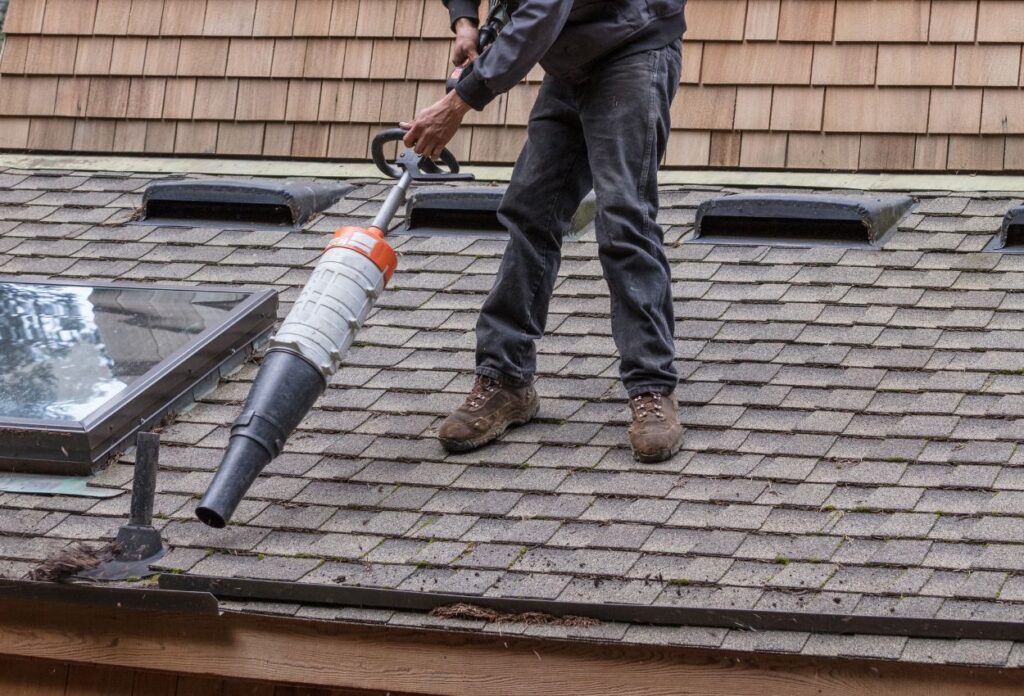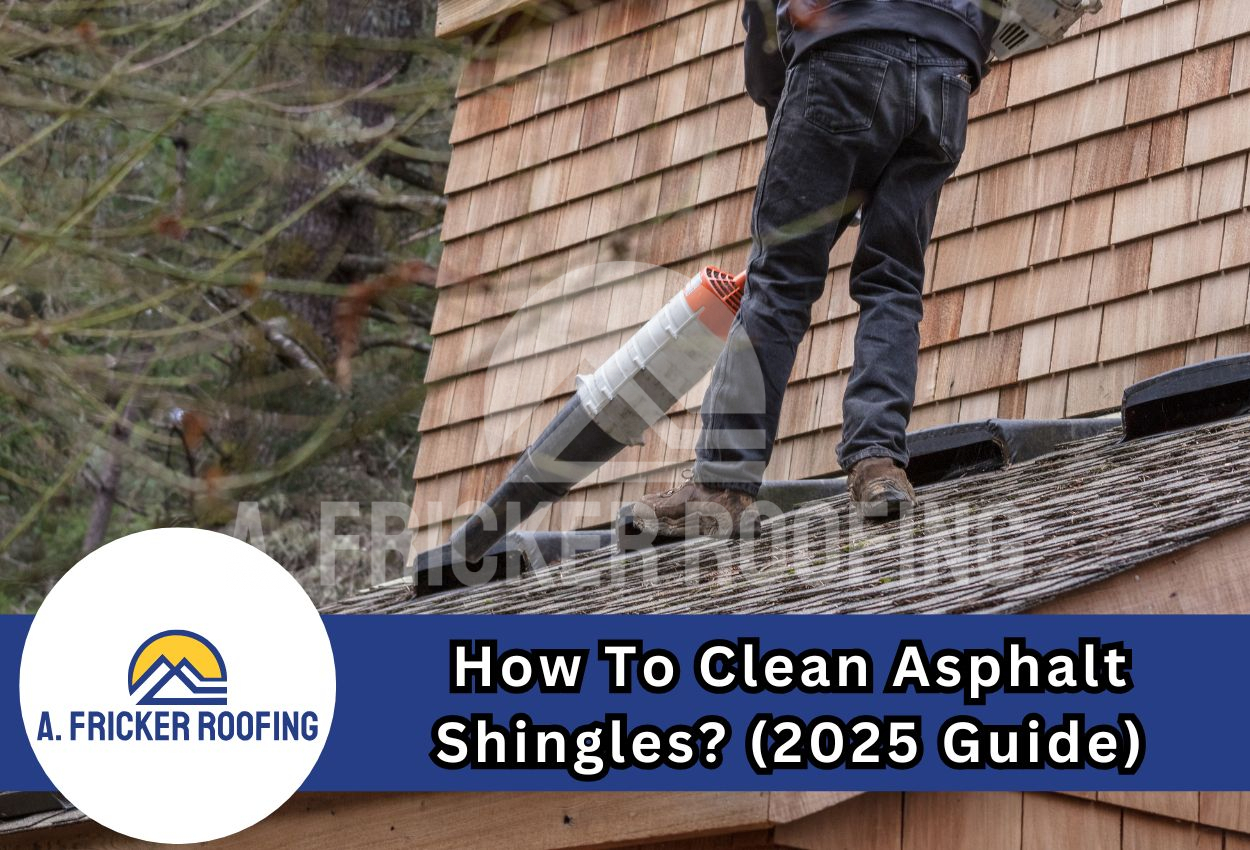Cleaning your roof’s asphalt shingles doesn’t just keep your home looking sharp, it also helps your roof last longer, especially here in Tulsa, where the weather can go from blazing sun to ice storms in a matter of days.
Asphalt shingles are the most common roofing material in the U.S. (covering about 80% of homes), and in a place like Tulsa, knowing how to clean asphalt shingles is important. In this guide, we’ll break down why roof cleaning matters, how to do it safely, the best DIY and professional cleaner options, and what to avoid if you want to keep your roof in top shape.
Why Should You Clean Your Asphalt Shingles?

If you see black streaks, mossy patches, or piles of leaves on your roof, that’s not just a cosmetic issue, it’s a red flag. Over time, all that gunk can trap moisture, lift shingles, and even cause leaks if you don’t clean asphalt shingles regularly.
In Tulsa’s mix of sun, storms, and humidity, moss tends can wedge its way under shingles, making them more likely to blow off in high winds. Algae holds onto moisture, which slowly wears down your roof’s protective surface. Any debris that builds up over time, especially in valleys and gutters, can cause to water back up and seep underneath shingles. If not removed, these growths and debris can significantly shorten the lifespan of your asphalt shingles and lead to major repairs down the road. Regular cleaning helps protect your roof, keeps it looking good, and ensures it lasts as long as it should.
What’s that on Your Roof?
Between Tulsa’s humidity, tree cover, and stormy seasons, roofs here are prone to all kinds of buildup. Algae, specifically gloeocapsa magma, darkens over time, creating black lines or stains on your roof, and traps moisture. Moss thrives in shady corners and can grow under shingles edges, lifting them, especially during freeze-thaw cycles.
Lichen may grow on roofs, too. It’s made of algae and fungus that clings tight to asphalt shingles and holds moisture. Natural debris like leaves, twigs, and dirt can pile up in valleys, and stains from rust or bird droppings can lead to stains and lower curb appeal. All of it can damage your roof if left unchecked.
Safety First: Before You Step on the Roof
Roof cleaning might sound simple, but there are significant risks involved. Staying safe should always come first.
- Know your limits: If your roof is steep, tall, or you’re not comfortable climbing up there, it’s better to call a professional.
- Don’t go solo: Always have someone nearby to hold the ladder, hand you tools, or call for help if anything goes wrong.
- Gear up: Wear shoes with non-slip soles, gloves, and safety glasses. If your roof is steep, use a harness tied to a secure anchor. Always work from a stable ladder with a helper or use a standoff to protect the shingles.
- Watch for hazards: Look out for power lines and avoid cleaning on windy, rainy, or icy days.
- Move smart: Walk slowly and stay low on the roof surface. When possible, clean from a ladder rather than walking on the roof. If anything feels off, stop. Your safety is always the most important.
What You’ll Need to Clean Your Roof
- Extension ladder
- Garden hose with spray nozzle
- Pump sprayer
- Soft-bristle brush or broom
- Safety gear (non-slip shoes, thick gloves, and safety goggles)
- Tarps or plastic sheets
- Cleaning solution (bleach, vinegar, oxygen bleach, or store-bought)
- Bucket and rope
When’s the Best Time to Clean Your Roof?
Timing matters more than you think. The right weather makes the job easier and safer.
- Go for Cool and Cloudy: Choose a mild, overcast day. Cleaners stay wet longer and work better, and you won’t be standing on a hot roof.
- Skip Rainy Forecasts: Rain right after cleaning can wash away your solution before it does its job, and a wet roof is very unsafe to be on. It’s also best to remove moss after a dry spell because dried-out moss brushes off more easily.
- Watch the Wind: Spraying bleach or vinegar in the wind can be impossible. Aim for calm conditions so the cleaner hits the roof.
- Start Early: Give yourself plenty of daylight. You don’t want to be climbing down in the dark.
- Avoid Freezing Temps: Cold weather can turn water to ice and render cleaners useless. Wait for a warmer day.
DIY Roof Cleaning Methods (That Actually Work)
If your roof isn’t too steep and you’re comfortable working on a ladder, you can handle the cleaning yourself, safely and effectively. Here’s how:
Start with a Gentle Scrub and Rinse
First, clear off any debris. Then use a soft broom or leaf blower to remove leaves and twigs. For moss, lightly brush downward with a soft-bristle broom. Don’t use wire brushes or scrape too hard because you could damage the shingles. Algae doesn’t need scrubbing since it clings flat and responds better to cleaning solutions. Finish this step with a gentle rinse using a garden hose (never a pressure washer).
Bleach and Water
If you’re wondering how to clean asphalt shingles with household solutions, this method is one of the most popular. Mix a 50/50 solution of laundry bleach and water and spray it on mossy or algae-stained areas. Let it sit for 15 to 20 minutes, then rinse from top to bottom with your hose. This method is highly effective for killing moss and algae. It’s important to protect your landscaping and plants with tarps and rinse them before and after. Wear gloves, goggles, and work in a well-ventilated space. This mix kills growth fast but needs careful handling.
Vinegar and Water
A 50/50 vinegar and water mix is a safer alternative if you’re concerned about plants or pets. Spray the solution, let it sit for 20 to 30 minutes, and rinse thoroughly. You may need to reapply on stubborn moss, but it’s a reliable, eco-friendly approach for mild buildup.
Oxygen Bleach
Oxygen-based cleaners like OxiClean or specialty roof products work more slowly but are safer for your roof and landscaping. Mix according to the label, spray, and allow 15 to 30 minutes to work before rinsing. This is also a great option if you want to clean moss off asphalt shingles without harming your plants.
Mild Soap and Water
A mix of dish soap and water can help with basic dirt and grime. It won’t kill moss or algae on its own, but it’s good for light cleaning and can be added to bleach or oxygen mixtures to help them stick better to the roof. Just rinse thoroughly when you’re done. It also works well if you need to clean bird droppings from asphalt shingles after a storm or nesting season.
When to Call a Pro for Roof Cleaning
- If your roof is extremely steep.
- If your house has multiple stories or you’re not comfortable with heights.
- If you don’t have the proper ladders or safety gear.
- If the moss or algae is so widespread, you think it’s beyond a simple spray from the edge.
- If you have any health issues that make climbing risky.
- If you don’t want to deal with chemicals and scrubbing.
If you’re wondering, ‘Can you clean asphalt shingles on your own?’ the answer is yes, but only if the roof is safe and the growth isn’t extreme. But if you hire someone, you can ask them how to prevent issues in the future. A professional might give you some tips about trimming trees or suggest installing zinc strips to prevent future growth.
Best Product To Clean Asphalt Shingles
If you’re not into DIY solutions, these are the best commercial products to clean asphalt shingles whether you’re dealing with moss, mold, or algae. All use safe, proven chemicals to clean asphalt shingles without damaging them.
1. Wet & Forget Ready-To-Use Outdoor Cleaner
A no-rinse spray that comes with an attached sprayer. Just apply and let rain gradually wash away moss, mold, and algae over time.
2. Spray & Forget Revolutionary Roof Cleaner Concentrate
This product is sprayed on and works almost instantly. It is best for stains left by moss, algae, and mold.
3. 30 Seconds Outdoor Cleaner
A bleach-based solution that works quickly. Spray it on, let it sit for a few minutes, and rinse off. Great for curb appeal, but it requires more caution around plants and painted surfaces.
4. Roof Cleaner OX 4500 by Wash Safe
An oxygen bleach formula that’s gentler than chlorine. Mix with water and apply with a pump sprayer. It’s safe for shingles and landscaping, and a good middle-ground option.
5. Corry’s Moss B Ware
This solution is available in granules or liquid. It is slower to act, but ideal for keeping moss from regrowing, especially on shaded or north-facing roofs.
What Not to Do When Cleaning Asphalt Shingles
Even with good intentions, it’s easy to damage your roof if you’re not careful. Avoid these common mistakes:
- Skip the pressure washer: High-pressure water can strip off protective granules, force water under shingles, and shorten your roof’s life. Stick with gentle rinsing methods.
- No metal tools or heavy scrubbing: Wire brushes and scrapers can gouge shingles. Use soft bristles and a light hand.
- Don’t clean in extreme heat: Hot shingles soften and scuff easily. Plus, cleaners dry too fast to work properly. Aim for a cool, overcast day.
- Protect your plants: Cleaners can harm landscaping. Always pre-wet greenery, use tarps if needed, and rinse everything after the job.
- Don’t mix chemicals: Combining products like bleach and ammonia creates dangerous fumes. Stick to one method at a time and rinse well before switching.
- Avoid steep or slippery roofs: If footing isn’t secure, don’t risk it. A safe cleanup is more important than reaching every spot.
- Handle shingles with care: Rough steps, dropped tools, or dragging hoses can damage them. Work slowly and gently.
The best way to clean asphalt shingles is always the safest: use soft brushes, low-pressure rinsing, and a proven roof-safe solution.
How Often Should You Clean Your Roof?
You don’t need to climb up there every month, but your roof does need regular attention. If you see moss, algae streaks, or piles of leaves, it’s time to act. Plan for a light cleaning once a year, or every two years if your roof stays fairly clean. After storms, do a quick debris check, especially in roof valleys and gutters. Spring and fall are ideal times in Tulsa to clean asphalt shingles, especially after storms or heavy tree shedding. Just remember even if your shingles look fine, clearing off leaves and dirt regularly goes a long way toward preventing bigger issues later on.
Final Thoughts
Keeping your roof clean is simple maintenance that saves you big down the road. Whether you DIY or hire a professional, regular roof cleaning prevents leaks, rot, and ugly stains.
If you’re not sure what your roof needs or you’d rather skip the ladder, call A. Fricker Roofing and Waterproofing. We’ve helped Tulsa homeowners keep their roofs in top shape for years.
Need help with a mossy or streaky roof? Contact us at (918) 402-7167 for a free quote or an inspection.
FAQ’s
A: Yes, you can clean asphalt shingles with bleach if it’s used properly. A 50/50 solution of household bleach and water is one of the most effective ways to remove algae, mold, and mildew. Apply it carefully and rinse thoroughly to avoid damaging the shingles or nearby vegetation.
A: Oxygen bleach is typically the safest and most eco-friendly option for removing moss from asphalt shingles. It’s less harmful to your landscaping and still effective. Scrub gently with a soft brush after letting the solution sit, then rinse with water.
A: Spring and fall are the best times to clean your asphalt shingle roof in Tulsa. Mild temperatures make it safer to work on the roof, and it’s easier to spot and remove debris, moss, or stains that built up over winter or summer.

